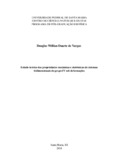| dc.creator | Vargas, Douglas Willian Duarte de | |
| dc.date.accessioned | 2019-05-07T14:49:21Z | |
| dc.date.available | 2019-05-07T14:49:21Z | |
| dc.date.issued | 2018-08-02 | |
| dc.identifier.uri | http://repositorio.ufsm.br/handle/1/16428 | |
| dc.description.abstract | In this work we study two dimensional materials compounds of group IV elements such as
graphene, silicene and germanene under biaxial and uniaxial strain. The aim of this study is
understand the mechanical properties of these materials and how the strain modify their electronic
properties. Using the density functional theory as implemented in the Quantum ESPRESSO (QE)
package, we determined the Lamé coefficients and using its coefficients we calculated the elastic
constants C11 and C12. The Young modulus in two dimension and the Poisson ratio was obtained
via uniaxial strain in two directions: armchair and zigzag. Using the Voigt approximattion we
estimated the Bulk modulus and the Shear modulus. All of those values are in good agreement
with the literature where graphene is characterized as a stiffness material. We analyzed the
stress-strain relation for all of three materials in the elastic region, where was observed an
asymmetric behavior in ultimate tensile strength, where the armchair direction is the more stiff.
The electronic properties was analyzed under uniaxial strain in three regions: linear (" = 0; 03),
harmonic (" = 0; 09), and near to ultimate tensile strength (" = 0; 15). Graphene under strain
does not show significant changes in its electronic properties. On the other hand, silicene and
germanene show the autodopping behavior, where electrons (tipe n conductivity) or/and holes
(tipe p conductivity) appear near to the Fermi level, in the vicinity of the Dirac cone greater
than 9%. This way, we showed that strain can control the conductivity properties of silicene and
germanene. | eng |
| dc.description.sponsorship | Coordenação de Aperfeiçoamento de Pessoal de Nível Superior - CAPES | por |
| dc.language | por | por |
| dc.publisher | Universidade Federal de Santa Maria | por |
| dc.rights | Attribution-NonCommercial-NoDerivatives 4.0 International | * |
| dc.rights.uri | http://creativecommons.org/licenses/by-nc-nd/4.0/ | * |
| dc.subject | Estrutura eletrônica | por |
| dc.subject | DFT | por |
| dc.subject | Constantes elásticas | por |
| dc.subject | Coeficientes de Lamé | por |
| dc.subject | Módulo de Young | por |
| dc.subject | Razão de Poisson | por |
| dc.subject | Tensão-deformação | por |
| dc.subject | Grafeno | por |
| dc.subject | Siliceno | por |
| dc.subject | Germaneno | por |
| dc.subject | Electronic structure | eng |
| dc.subject | Elastic constants | eng |
| dc.subject | Lamé coefficients | eng |
| dc.subject | Young modulus | eng |
| dc.subject | Poisson ratio | eng |
| dc.subject | Stress-strain | eng |
| dc.subject | Graphene | eng |
| dc.subject | Silicene | eng |
| dc.subject | Germanene | eng |
| dc.title | Estudo teórico das propriedades mecânicas e eletrônicas de sistemas bidimensionais do grupo IV sob deformações | por |
| dc.title.alternative | Theoretical study of mechanical and electronic properties of bidimensional systems of group IV under strain | eng |
| dc.type | Dissertação | por |
| dc.description.resumo | Neste trabalho estudamos materiais bidimensionais submetidos a deformações biaxias e uniaxiais.
Este estudo visa entender as propriedades mecânicas destes materiais e como essas deformações
afetam as propriedades eletrônicas grafeno, siliceno e germaneno. Através da teoria do funcional
da densidade (DFT), implementada no código computacional Quantum ESPRESSO (QE),
determinamos os coeficientes de Lamé, e com estes determinamos as constantes elásticas
C11 e C12. O módulo de Young e razão em duas dimensões de Poisson foram obtidos via
deformações uniaxiais nas direções armchair e zigzag. Utilizamos a aproximação de Voigt
para calcular o módulo de Bulk e módulo de Cisalhamento. Os resultados obtidos estão de
em acordo com os valores previstos na literatura para as propriedades mecânicas analisadas,
onde o grafeno apresentou ser o material mais rígido entre os estudados. Analisamos a curva de
tensão-deformação para os três materiais no regime elástico, onde foi observado uma assimetria
na tensão limite e deformação limite sendo a que apresentou maior resistência encontra-se na
direção armchair. As propriedades eletrônicas foram analisadas sob deformações uniaxias
para três regimes: na região linear (" = 0; 03), na região harmônica (" = 0; 09) e próximo
da tensão limite (" = 0; 15). Para o grafeno não observa-se mudanças significativas em suas
propriedades eletrônicas. Porém para o siliceno e germaneno observa-se o aparecimento de um
caráter autodopante com a presença de elétrons (condução do tipo n) e/ou buracos (condução do
tipo p) nas imediações do nível de Fermi, ou seja, nas proximidades do cone de Dirac. Deste
modo temos que devido a deformações e/ou tensões aplicadas pode-se controlar a condutividade
do siliceno e germaneno. | por |
| dc.contributor.advisor1 | Baierle, Rogério José | |
| dc.contributor.advisor1Lattes | http://lattes.cnpq.br/7565203547830128 | por |
| dc.contributor.referee1 | Rupp, Caroline Jaskulski | |
| dc.contributor.referee1Lattes | http://lattes.cnpq.br/2244372613117182 | por |
| dc.contributor.referee2 | Silva, Ricardo Barreto da | |
| dc.contributor.referee2Lattes | http://lattes.cnpq.br/8538297526477728 | por |
| dc.creator.Lattes | http://lattes.cnpq.br/5573393060161481 | por |
| dc.publisher.country | Brasil | por |
| dc.publisher.department | Física | por |
| dc.publisher.initials | UFSM | por |
| dc.publisher.program | Programa de Pós-Graduação em Física | por |
| dc.subject.cnpq | CNPQ::CIENCIAS EXATAS E DA TERRA::FISICA | por |
| dc.publisher.unidade | Centro de Ciências Naturais e Exatas | por |



